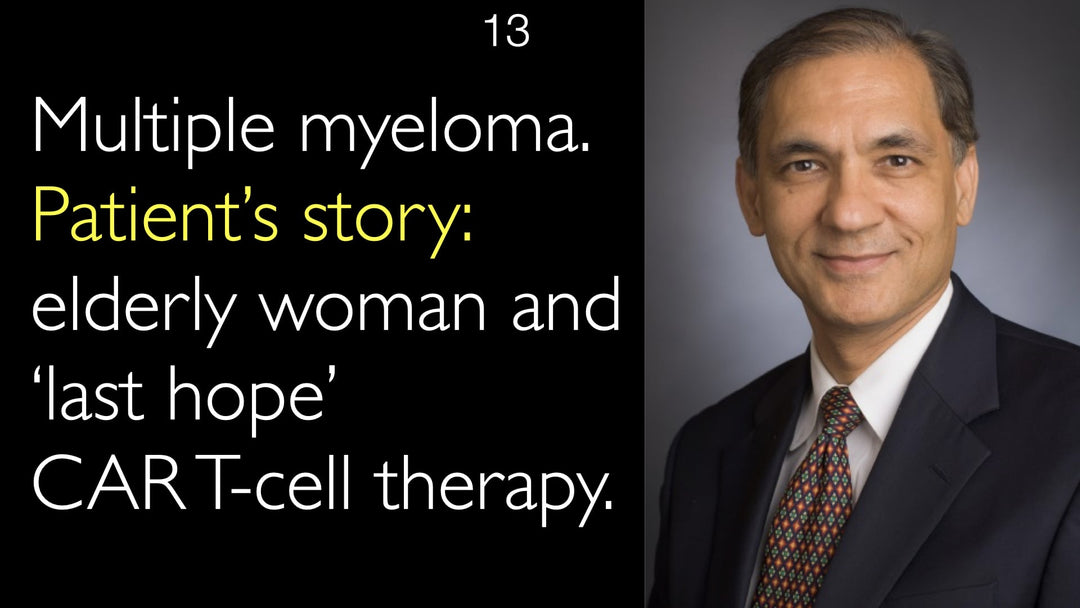Leading expert in myeloproliferative disorders, Dr. Aric Parnes, MD, explains the four main types of these blood cancers. He details how treatment is guided by specific genetic mutations like JAK2, CALR, and MPL. Dr. Aric Parnes, MD, highlights the importance of the Rapid Heme Panel, a test for 95 mutations, in achieving a precise molecular diagnosis. This personalized approach ensures patients receive the most effective targeted therapies available.
Personalized Treatment of Myeloproliferative Neoplasms Based on Genetic Mutations
Jump To Section
- Understanding Myeloproliferative Disorders
- The Role of Genetic Mutations in Diagnosis
- Personalized Treatment Approaches
- Advances in Myelofibrosis Therapy
- The Importance of the Rapid Heme Panel
- The Value of a Medical Second Opinion
- Full Transcript
Understanding Myeloproliferative Disorders
Myeloproliferative neoplasms (MPNs) are a collection of several neoplastic blood disorders. Dr. Aric Parnes, MD, a hematology expert, outlines the four main types. These include chronic myelogenous leukemia (CML), polycythemia vera, essential thrombocythemia, and primary myelofibrosis. Each disorder is characterized by the overproduction of a specific blood cell line.
In CML, white blood cell counts are highly elevated. Polycythemia vera involves an expansion of the red blood cell lineage. Essential thrombocythemia is defined by a high platelet count. Primary myelofibrosis is distinct, where fibroblasts in the bone marrow create scar tissue that crowds out normal blood-producing cells.
The Role of Genetic Mutations in Diagnosis
Precise molecular diagnosis is the cornerstone of modern myeloproliferative disorder treatment. Dr. Aric Parnes, MD, explains that a decade ago, specific diagnostic tests were lacking. Today, key driver mutations have been identified that cause these diseases. The JAK2 mutation is responsible for 95% of polycythemia vera cases and about 50% of essential thrombocythemia and primary myelofibrosis cases.
For cases without a JAK2 mutation, discoveries of calreticulin (CALR) gene mutations and MPL (thrombopoietin receptor gene) mutations now provide answers. Dr. Anton Titov, MD, emphasizes that diagnosis now relies on more than just clinical symptoms and microscopic blood smear analysis. Identifying these genetic abnormalities is critical for classifying the disease and selecting therapy.
Personalized Treatment Approaches
Treatment of myeloproliferative disease is highly personalized and depends on the specific genetic mutation identified. For Philadelphia chromosome-positive CML, which features the Bcr-Abl fusion protein, targeted therapy with the tyrosine kinase inhibitor imatinib (Gleevec) is highly effective. This represents a major success in precision medicine for blood cancers.
Treatment for polycythemia vera often involves therapeutic phlebotomy (bloodletting) or chemotherapy to control the overproduction of red blood cells. For essential thrombocythemia, treatment aims to manage the high platelet count and reduce the risk of clotting. The choice of medication is guided by the patient's specific mutation profile and overall risk assessment.
Advances in Myelofibrosis Therapy
Myelofibrosis treatment presents a unique challenge due to the replacement of bone marrow with scar tissue. Dr. Aric Parnes, MD, discusses the JAK2 inhibitor medication Ruxolitinib, which is approved for this condition. Ruxolitinib is effective at relieving symptoms like spleen enlargement and night sweats, improving a patient's quality of life.
However, Dr. Aric Parnes, MD, notes a significant limitation: Ruxolitinib does not stop the progression of the underlying myeloproliferative disease. This highlights the ongoing need for more effective, disease-modifying therapies for myelofibrosis patients. Research continues to develop new agents that target the root genetic causes.
The Importance of the Rapid Heme Panel
A significant advancement in diagnostics is the Rapid Heme Panel. Dr. Aric Parnes, MD, describes this as a comprehensive molecular test that screens for 95 genetic mutations frequently found in blood cancers. This panel includes the critical mutations for MPNs: JAK2, CALR, and MPL. It allows for a simultaneous analysis of nearly a hundred potential genetic drivers of disease.
Dr. Anton Titov, MD, notes that this technology allows for a precise molecular diagnosis, moving beyond traditional methods. By quickly and cheaply identifying the exact genetic cause of a hematologic disorder, oncologists can confidently select the best, most personalized treatment strategy for each individual patient from the outset.
The Value of a Medical Second Opinion
Given the complexity and rapid evolution of treatment for myeloproliferative disorders, seeking a medical second opinion is highly valuable. A second opinion helps to confirm that a myeloproliferative disorder diagnosis is correct and complete. It ensures that all relevant genetic testing, like the Rapid Heme Panel, has been performed and interpreted accurately.
Furthermore, a consultation with a specialist like Dr. Aric Parnes, MD, can provide assurance that the chosen treatment plan is the most current and appropriate option based on the latest research and clinical guidelines. This step is crucial for optimizing patient outcomes in these complex diseases.
Full Transcript
Dr. Anton Titov, MD: Myeloproliferative disorder treatment is reviewed by a top hematology oncology expert. There are four types of myeloproliferative disorders. Treatment of myeloproliferative disease depends on genetic mutations.
How do Bcr-Abl fusion protein, JAK2, CALR, and MPL gene mutations affect therapy choice? How does the Rapid Heme Panel of 95 genetic tests help to personalize treatment of myeloproliferative disorder?
Myeloproliferative disorder treatment begins with a correct molecular diagnosis. JAK2, calreticulin, and Philadelphia chromosome mutations give rise to different subtypes of myeloproliferative disease.
Dr. Aric Parnes, MD: Expansion of the red blood cell lineage causes polycythemia vera.
Dr. Anton Titov, MD: Treatment of polycythemia vera is with bloodletting or chemotherapy.
Myeloproliferative disorder treatment is personalized for each patient. Expansion of fibroblasts in the bone marrow causes myelofibrosis. Chemotherapy regimens in myelofibrosis treatment depend on the exact genetic mutation identified.
Medical second opinion helps to make sure myeloproliferative disorder diagnosis is correct and complete. It also helps to choose the best treatment for myeloproliferative disease.
Thrombocytosis (essential thrombocythemia) treatment can also be done by the JAK2 inhibitor Ruxolitinib. Myeloproliferative disorder treatment is advancing rapidly.
Dr. Aric Parnes, MD: The Rapid Heme Panel is a new genetic diagnostic test. It quickly and cheaply tests for 95 genetic mutations common in blood disorders, including myeloproliferative disease.
Dr. Anton Titov, MD: Myeloproliferative diseases are a collection of several neoplastic disorders. Their incidence is increasing.
What are myeloproliferative disorders? How are they diagnosed? What is the current treatment of myeloproliferative disorders?
Dr. Aric Parnes, MD: There are four myeloproliferative diseases. Each disorder reflects a specific blood cell line. CML is chronic myelogenous leukemia. It is a myeloproliferative disorder. Patient's white blood cell counts are high.
Dr. Anton Titov, MD: CML is a disease that can be treated with the medication Gleevec.
Dr. Aric Parnes, MD: Yes. Imatinib was the tyrosine kinase inhibitor that targets the Bcr-Abl Philadelphia chromosome fusion protein.
Sometimes the red blood cells are elevated. We call this myeloproliferative disease polycythemia vera. Sometimes the platelets are elevated. Then we call this essential thrombocythemia.
The fourth myeloproliferative disorder is really different than the others. This is called primary myelofibrosis or idiopathic myelofibrosis. Fibroblasts in the bone marrow are making fibrous tissue. Scar tissue replaces normal bone marrow in myelofibrosis.
In the first three myeloproliferative disorders, there is a proliferation of blood cell production. The blood counts decline in myelofibrosis.
Dr. Anton Titov, MD: Because in myelofibrosis, proliferating fibroblasts crowd out normal hematopoietic cells?
Dr. Aric Parnes, MD: Exactly, yes.
There is a great increase in our understanding of myeloproliferative diseases in the last 10 years. Earlier we did not have any specific tests for these disorders.
Now we know that JAK2 mutation is responsible for 95% of polycythemia vera cases. JAK2 mutation is also responsible for 50% of essential thrombocythemia and 50% of primary myelofibrosis cases.
A diagnostic test for JAK2 mutation was developed. There is also now a JAK2 inhibitor medication. It is called Ruxolitinib. Unfortunately, it doesn't work very well. Ruxolitinib is only approved for myelofibrosis.
Ruxolitinib helps to relieve symptoms of myelofibrosis. But it does not stop the myeloproliferative disease progression.
We have already mentioned specific targeted therapy by imatinib (Gleevec) in chronic myelogenous leukemia, CML. This medication targets the Philadelphia chromosome (Bcr-Abl fusion protein).
Philadelphia chromosome-positive chronic myelogenous leukemia is a distinct disease entity. Its symptoms are quite specific. They reflect blood hyperviscosity from high white blood cell counts in CML. CML has typical leukemia complications.
Other cases of chronic myelogenous leukemia do not have the Philadelphia chromosome by molecular analysis. We refer to this type of leukemia as Bcr-Abl negative myeloproliferative diseases.
Last year at the American Society of Hematology meeting, two research laboratories reported important discoveries. They found the cause of those essential thrombocythemia and idiopathic myelofibrosis cases that do not have the JAK2 mutation.
Mutations in the calreticulin (CALR) gene cause a significant share of myeloproliferative disorders that are JAK2 negative. The third gene that also has a role in myeloproliferative diseases, especially primary myelofibrosis, is called MPL (thrombopoietin receptor gene).
Dr. Anton Titov, MD: We talked about myelodysplastic syndrome. We already discussed our Rapid Heme Panel. It is a molecular test that screens for 95 genetic mutations. These mutations are frequent in blood cancers.
Now we included JAK2, CALR, and MPL gene mutations in our Rapid Heme Panel. This allows us to analyze 95 mutations for all myeloproliferative diseases in one test.
Dr. Anton Titov, MD: Your rapid heme panel analyzes 95 genetic mutations. They are frequent in blood cancers. This allows a precise molecular diagnosis. It allows correct identification of the exact causes of hematologic disorders.
Diagnosis is based not only on clinical symptoms and blood smear study under a microscope. Precise molecular diagnosis of hematologic malignancy or non-malignant disorder allows selection of the best treatment for a specific patient.
Dr. Aric Parnes, MD: That is right. That is right.
Before we discovered the role of all these genes in myeloproliferative disorders, we did not have diagnostic tests. Now we do have good diagnostic tests for many blood diseases. We hope to develop targeted therapies for them.
Dr. Anton Titov, MD: Myeloproliferative disorder treatment. Video interview with a top expert in hematology. CML, polycythemia vera, essential thrombocythemia, myelofibrosis therapy.
Myeloproliferative disorder treatment is reviewed by a top hematology oncology expert. How does personalized treatment of myeloproliferative disease depend on specific mutations? How do Bcr-Abl fusion protein, JAK2, CALR, and MPL gene mutations affect therapy choice? How does the Rapid Heme Panel of 95 genetic tests help to personalize treatment of myeloproliferative disorder?







